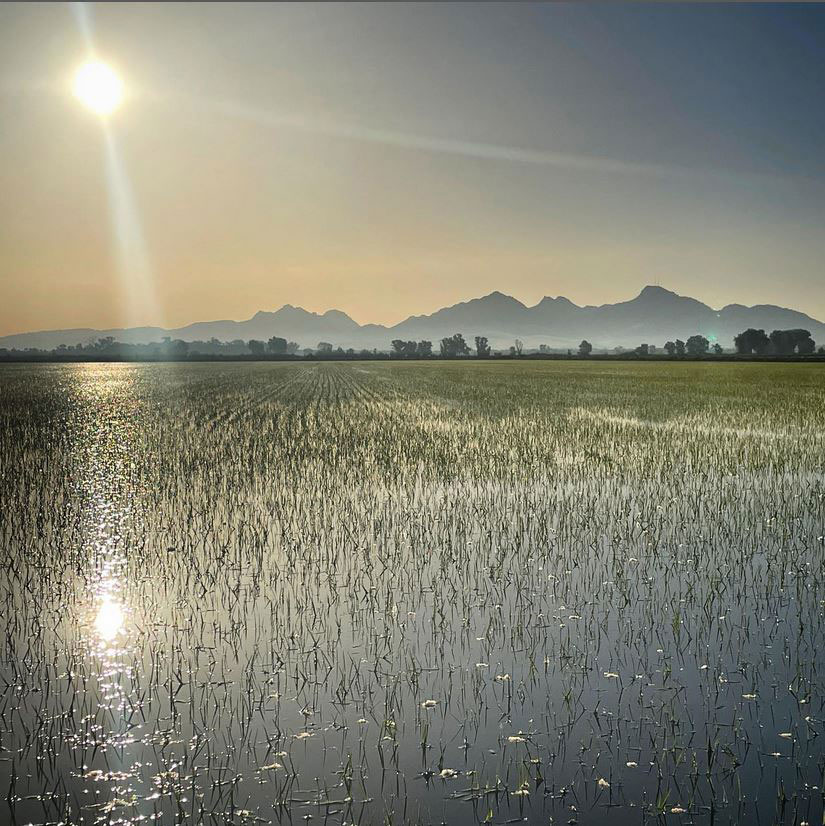 Picture postcard rice production from Kurt Richter in Maxwell CA
Picture postcard rice production from Kurt Richter in Maxwell CA
May 17, 2023
MOUNTAIN HOME, TX – Rice planting is underway in California, but not without some challenges. Last year the state’s rice acreage was dramatically reduced because of water shortages. This year the ample winter rains and snowpack will allow for greatly expanded acreage, but later than normal rains this spring have hampered planting progress in most areas.
“The great news is that our water allocations are good. However, we have had a cool, wet spring which delayed working fields and planting,” said UC Davis Rice Agronomist Dr. Bruce Linquist. “That said, we have now had a nice warm week and there is no rain in the forecast. On an average year, 50 percent of the California rice crop is planted by May 11. I am guessing that this year it will be delayed by up to a week or more, but most, if not all acreage will be planted. Despite the delay, I don’t hear anyone complaining – they are happy to be growing rice considering what we went through last year.”
Following is a crop report from north to south and west to east in the California rice growing region.
Seth Fiack, who farms near Glenn, about 90 miles northwest of Sacramento, has two-thirds of his crop planted and hopes to have the remaining crop completed in four to five days. “All the acres in my area will be planted. Rice has been jumping out of the ground with the recent warm weather and stands look good.”
Thirty miles south, near Williams, Leo LaGrande says his crop is 40 percent planted. Ground drying in that area has been a struggle this spring and has prolonged their planting season by two weeks. LaGrande also mentioned he is encountering less than desirable conditions for seedbed preparation.
Further south, near Arbuckle, Alex Struckmeyer, is just beginning seeding, and predicted his prospective acreage will be reduced by 200 acres because he simply will not have time to get water across them by June. He noted, “water deliveries and fertilizer and seed availability is being stretched to the max with so much ground coming back into production after last year’s reduction.”
Kim Gallagher farms a little further southeast, near Knights Landing. “We are more than 50 percent planted and most of our neighbors are similar,” she said. “I have seen some of the fastest field work ever this year. Everyone is just happy to have water to put in a crop.”
Brian McKenzie, whose family operation is near Sacramento, is about 50 percent planted but estimates his region is closer to 25 percent. Ground that McKenzie had prepped to be fertilized and flooded received rain, which necessitated additional preparation. McKenzie said less than ideal seedbed preparation will lead to early weed germination, which could complicate weed control.
Headed back north but on the east side of the Sacramento Valley, Nicole Van Vleck, at Montna Farms near Yuba City, reports that her farm is currently near half planted. “The warmer weather now is helping get the rice plants moving. We will plant 100 percent of our acres, as will our neighbors.”
Thirty miles north of Yuba City, near Richvale, Peter Rystrom is about one-third planted but he also will reduce intended acreage by 10-15 percent because of weather difficulties.
A similar report of reduced acreage due to delays in getting the crop in comes from Derek Sohnrey and his operation in Durham, which is just south of Chico. Sohnrey has planted about 40 percent of his crop and is in the process of flooding many more acres.
Dr. Dustin Harrell, director of the Rice Experiment Station near Biggs, said the research facility is experiencing similar difficulties. “We are about 20 percent planted in our research areas and should be able to plant our first foundation seed field this week.”
While California growers have had some difficulties getting a rice crop planted this year, overall, the industry is blessed to have the water availability to plant close to a normal-sized crop and predictions are that acreage will be 450,000 acres or above.